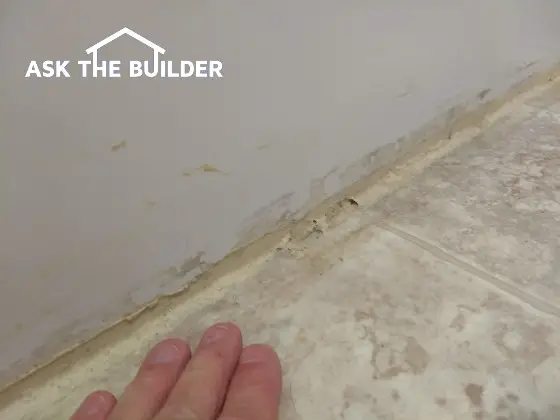
This caulk mess could have been avoided with a grout sponge and pride. (C) Copyright 2018 Tim Carter
Caulking Doesn’t Have to Be Hard
QUESTION #1: Tim, my husband caulked a few things in the bathroom and made an enormous mess. The caulk is smeared and there are gaps. Can it be repaired? He had the best of intentions but didn’t seem to be concerned about the final appearance. How does one get a perfect bead of smooth caulk with no excess and no smearing? Angie C., Mt. Desert, ME
Have you seen smeared caulk like Angie now has in her bathroom? I see it all the time, especially when I travel. Frequently I want to take photographs of the botched workmanship in the restrooms in airports and interstate highway rest stops, but I dare not get out my camera as I fear being arrested as a creeper!
The good news is that crappy caulk jobs can be repaired with relative ease. You can purchase a variety of caulk-removal solvents that soften most caulks. With the caulk softened, you can scrape the goo away without damaging the nearby surfaces and finishes.
Be sure you read the label of the solvent to ensure it’s safe to use on the things the caulk is touching. If in doubt, do a small test in an out-of-the-way area to ensure the solvent doesn’t dull the finish, remove color, or otherwise damage the fixtures, flooring, or trim.
Creating a smooth professional caulk joint is extremely simple. The process starts with an excellent caulk gun. Cheap caulk guns provide little control over the amount of caulk that oozes from the tube as you squeeze the handle. Better caulk guns, that cost just a little more, give you great control as the push rod that presses the back of the caulk tube only advances a small amount as you squeeze the handle of the gun.
You also need to cut the tip of the caulk tube so the hole at the end of the tube is no bigger than 1/8 inch. The goal is to lay down a bead of caulk that is just enough to fill the gap allowing no excess to be removed. This technique only comes with lots of practice.
The easiest caulks to work with are ones that are water-based or can be cleaned up with water. I fill a 3.5-gallon bucket with warm water and have one of my special tile grout sponges handy. These sponges have no sharp edges or corners.
I apply the caulk to about 2 feet of the crack or gap. I then tool the caulk with my finger creating a concave appearance. If I applied too much caulk and excess starts to build upon my finger or begins to smear, I lift my finger off the caulk and wipe the excess off my fingertip farther down the crack or gap so no caulk is wasted.
The final step is to take the damp sponge will all excess water squeezed out, and slide it softly across the fresh caulk to remove any smears and to give it a very smooth appearance. Don’t press hard on the sponge while doing this step. Practice on a test crack to master the sponging technique.
I’ve created a page on my website for you that has caulk installation videos and other tips. Go to: caulk
Building Lot Tips
QUESTION #2: Tim, I’m starting to look at lots for a new home. I’ve got no clue as to what’s a good lot and what’s not. What tips can you share about this process? I’m fearful of making a costly mistake. Keith C., Syracuse, NY
Each week I do autopsies for homeowners who have problems at their homes. In many cases, the root cause of the problem is a bad building lot.
I have so many building lot articles on my website that I no doubt could assemble the information into a small book. There are so many things to consider, but here are a few of the major deal-breakers for me.
The size of the lot is important. Will you be able to fit the house and all other things like sheds, decks, patios, etc. you want inside the setback lines as defined in the local zoning code? Is the lot too steep for the house or will it cause driveway issues?
Are all the utilities you need available? If the lot is undeveloped, how hard and expensive is it to get electric to your home from the street? What about Internet access? Is it readily available and the speed you need available?
Compass direction can be critical. The back of my house has a huge deck on it and faces east. I like that so I don’t broil in the intense afternoon sun while on the deck. What about the soil? Is it thin requiring you to blast? Does the lot have great drainage?
I’ve got lots of FREE extra building lot tips for you at my website: buildinglot
Column 1272
The post Caulking Doesn’t Have to Be Hard and Building Lot Tips appeared first on Ask the Builder.
Via Home http://www.rssmix.com/
No comments:
Post a Comment